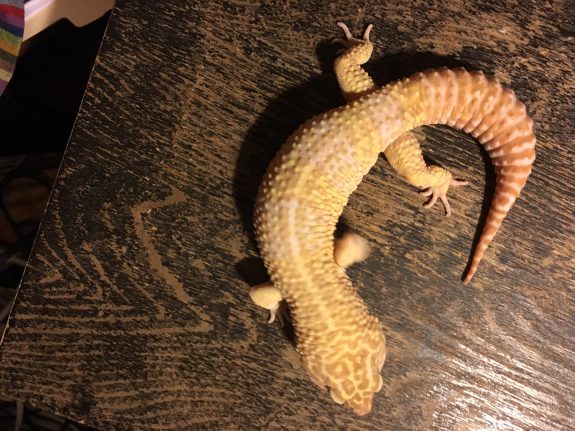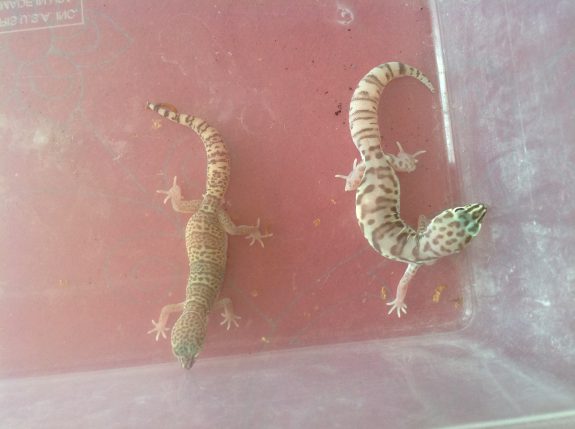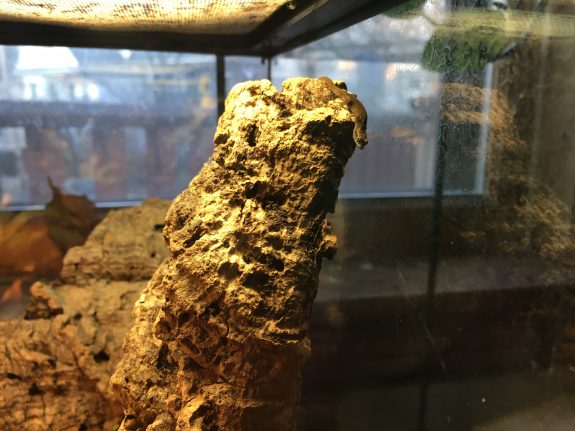Gecko Time has gotten many frantic requests for assistance from people whose geckos have escaped their cages ever since running the article Find an Escaped Gecko in January 2010. In addition to the understandable worry about re-locating a missing pet, there is usually tremendous concern about clutter in the house, cats, dogs and openings in walls or stairwells that will make the retrieval job more difficult. Even the miraculous story of one of my geckos found after 2 years sojourn somewhere in the house doesn’t seem to help people feel better. Though I can’t guarantee that a lost gecko can be found, I thought that a few more stories about miraculous gecko (and one non-gecko) finds might rekindle some hope.
My house is a nightmare for finding lost geckos: open hot air vents, lots of clutter, pocket doors and two predatory cats make me feel hopeless if I can’t locate them under the couch within a few hours of their disappearance. Even so, I’ve experienced some incredible recoveries.
Descent Through the Walls
My oldest leopard gecko, Eragon, the foundation of my leopard gecko breeding project got a taste of freedom accidentally about 10 years ago. If anyone tells you that geckos don’t remember anything, don’t believe them. The next time Eragon had the opportunity, he took off. I searched all the usual spots –under the couch, along the cluttered walls– and found no sign of him. A few weeks passed and I gave up. I started thinking about needing to replace my primary gecko breeder male. Then I got a call from the downstairs neighbors. Was I missing a gecko? Eragon had turned up in their linen drawer! How was this possible? Each unit in our two family house has a set of pocket doors that fold into the wall and right next to them is a built-in corner cabinet. Eragon had most likely fallen through the hole inside the upstairs pocket doors and climbed into the downstairs linen drawer from the back. He is now 13 years old and has given up his outside adventures.

The Little Hatchling that Could
Coleonyx variegatus is a small gecko native to southwest United States that seldom exceeds 3″ in total length as an adult. When C. variegatus hatch, they can fit on a US quarter. I keep the hatchlings in a rack in 6qt tubs. The first year I had the rack, which I bought from someone who had built it himself, I didn’t realize that the tubs were just a little too low for the shelves. I had several escapees, including a tiny C. variegatus hatchling who took off one year in October. I didn’t even bother looking. How was I going to find such a tiny gecko in my cluttered home? Three months later, in January, I happened to see a flash of yellow out of the corner of my eye. Was it possible? Surely not! Even so, I set up a small hide a water bowl and a bowl of mealworms. Within a week I found the no-longer-a-hatchling snacking away.

Arboreal Parade
Arboreal geckos can be easier to find since they tend to move upwards rather than downwards when they escape. I’ve “lost” several arboreal geckos and have recovered every single one. The first time was about 12 years ago when I went away and had someone else care for what was then a pretty small gecko collection. When I returned I checked on everyone. My newest acquisition was a gold dust day gecko and as I looked in the cage I saw her. Wait a minute . . . isn’t she on the wrong side of the glass? There she was, sitting on top of the cage with her tail hanging down the glass side! My caregiver had left the door open briefly. I retrieved her with judicious use of a deli cup and she lived with me for another 10 years.
I have had to recapture the same L. williamsi twice. Both times (these guys are fast!) I saw a blue “comma” on my chartreuse dining room walls and was able to rush over with a deli cup. On one occasion, the gecko saw me coming and dive-bombed down to the floor so I had to go searching under furniture.
Igor the leachie has escaped twice due to my accidentally leaving the cage door open. I looked all over and couldn’t find her (yes, “her” after “he” laid eggs this season) but by the next day Igor had climbed up the furniture near the cages and was easy to locate.
I lost one crestie that appeared a week later minus a tail and with a bite mark from a cat. She has since recovered well and has no more desire to escape.
Not a Gecko
Years ago I decided to buy a blue lobster for my indoor-outdoor fish pond. I don’t know what possessed me since the tub that houses the pond is black and the lobster is very reclusive. Of course I never saw it. One day my husband was heading out the front door and he called to me “What’s this?” The lobster had decided to go walkabout and had managed to get out of the pond (which was indoors at the time), walk from the back to the front of the house, get down the stairs and wait by the front door. I returned him to the pond but realized that I had a problem. In a month, the pond would be moving outside to my second floor front porch and if he escaped again, he would end up two floors down in the garden. What to do? I decided to give him away since I couldn’t see him most of the time anyway. I had someone lined up to take him the day I moved the pond, which required emptying the tub of plants, fish and water and then re-filling it in its summer location. He was nowhere to be found! Of course I started looking through the house figuring that he’d gone for another walk. No luck. At the last minute I found him nestled in the gravel of one of the water plants under a brick I’d put in the pot. He’d doubled in size since I bought him and I was glad to find him a safe home.
Sphaerodactylus Struggles
I have recently gotten interested in micro geckos and purchased a few Sphaerodactylus macrolepis. These tiny geckos seldom exceed an inch and a half as adults. I bought two, and, over the course of a few months, one by one they disappeared. This was a real mystery. They were in a 12x12x12 exo-terra that had been specially escape-proofed for tiny geckos and had successfully housed a hatchling P. klemmeri of similar size. Eventually I figured out what must have happened: some of the tiny crickets I’d been using as prey had hidden themselves in the cork bark, matured, and snacked on these little geckos. I got another S. macrolepis and was diligent about checking the enclosure for crickets that were getting too big.
Eventually I decided I wanted to have a pair of these little geckos, set up a second enclosure, and bought a male to pair with what I thought was my female. I brought the male home, opened the deli cup and left it in the new enclosure so he could make his way out when he felt comfortable. After a few hours I removed the deli cup, but I never saw the gecko in the enclosure no matter how hard I searched. I figured that he must have somehow been clinging to the cup when I removed it and I hadn’t noticed. This escape turned out to be fortunate because I discovered that the gecko I already had was a male as well, not a female as I had thought. I had a tremendous regret that a gecko in my care had managed to escape due to my negligence but there was nothing I could do about it.
I’ve always worried that these tiny, speedy geckos would jump out of the enclosure as soon as I opened it. One day it seemed that my fears had been realized. I was sitting near the macrolepis cage and out of the corner of my eye I saw movement on the floor that didn’t look like a cricket. I clapped my hand over it and sure enough, it was a S. macrolepis. How had he gotten out? I tossed him back into the cage and resolved to be more vigilant in the future.

A few weeks went by. I carefully checked each time I fed my macrolepis to make sure it stayed in the cage. Despite all my care, it seemed to be having a hard time. There were pieces of shed stuck on it (I’m not about to try to “peel” shed off a gecko this small) and it seemed to be losing weight. Then one day I noticed that part of its tail was missing. Could this be voracious crickets again? I resolved to pull out each piece of cork bark and check for hidden crickets. Imagine my surprise when I pulled out a piece of cork bark only to have a second S. macrolepis jump out of it and run under the coffee table! The macrolepis I had “returned” to its cage was not the original male, but the second male that had been on the loose for the past 6 months. Unknowingly, I had been housing two males together and one had been harassing the other. Interestingly, the male that had been on the loose, while evidencing his lack of UVB by his kinked tail, was much bigger than the one I’d had in the cage all along. I guess I “lose” a lot more crickets than I thought. Today they reside in separate cages. The smaller male has regrown his tail, no longer has problems shedding and has gained weight.
The Moral of the Story
Never give up! Keep searching! Look “up” to find arboreal geckos and look “down” to find terrestrial ones. Keep an extra cage on hand because you never know when you may end up having to house a gecko that you’ve given up on.


I regret naming my gecko Houdini because he escaped and was lost in my apartment for a week. I thought I would find him squished beneath my roommate’s shoe (he is the same color as our kitchen floor!) or I would find him lying dead somewhere, starved, which would be devastating. Thankfully, he somehow found his way back to his tank and sat there in front of it, almost saying “hey, lemme in!” Such a relief! Your story about finding Eragon in a linen drawer is crazy! haha glad you found him.
Me too! I just found my 11 year old crestie, Spencer, sitting on the table in front of his cage the other night. I didn’t even know he’d gotten out.
my crestie shiro managed to make in my own words a pretty daring escape just only a month or so ago , my sister didnt close his door correctly when she was doing food switch out , he escaped sometime during the night hour, it was a whole day at least before i noticed he was gone because of the flu i avoided being near my reptiles mostly because of how sick i felt. i tore through my whole room being extremely caredul
while i did as well my sisters room , the bathroom , the shoe closet hell even my dads room thats on the other side of the house with the cats living in that room. guess where he was after a day of panic searching and tears of worry. in the god damn kitchen pantry sitting on the broom watching the whole damn time while i panicked. i even checked in the pantry earlier that day. i dont know where he was in there but he managed to hide pretty well.
Thanks for posting this. Any other stories of great finds are greatly appreciated and will give other people hope.
yet another escapee story that happened about a week before my crestie escaped( imagine my panic and heart ache ) my leopard gecko managed to scale out of her tank, find a way down a four foot dresser with out any injury. i didn’t notice her leave because well someone else was looking after her for me while i was out of town. thinking about the fact she went against three cats and a hyper active dog. She managed to leave the bedroom walk ten feet to the shoe closet and sit there for god knows how long before i finally found her after looking everywhere i could reach.